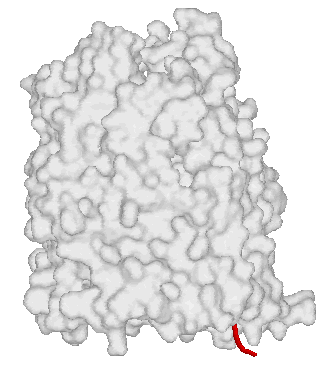- home - index - site map - 
Iron transport system in the outer membrane
of Escherichia coli
All organisms need iron as trace element. Iron is widely distributed on earth - but in aerobic environments mostly in a non water soluble state. Therefore at the very beginning of the nutrient chain the supply with iron is a fundamental problem. Microorganisms feed on iron in the form of chelates. The substances able to form chelates (siderophores) are secreted to the environment as organic molecules. To gain the iron complexes there are active transport systems, which for reasons of efficiency are located in the outer membrane of Gram-negative bacteria. This poses another problem: active transport requires energy, which however is supplied at the inner, cytoplasmic membrane only.

Escherichia coli produces and excretes enterobactin (a cyclic triester composed of 2,3-dihydroxy benzoyl serine) to catch iron from the environment. It binds Fe3+ with a binding constant of 1049 (which is 10 times the binding constant in oxidic bound iron) using six oxygen atoms. The iron bound enterobactin is transported by FepA (ferric enterochelin/enterobactin permease) into the periplasm. From the periplasm it is transported by an ABC-type system into the cytoplasm. The energy used for the transport across the outer membrane has to be transferred from the cytoplasmic membrane. Here are the proteins ExbB and ExbD (excretion of inhibitor of colicin B), which pass electrochemical energy of the proton gradient to TonB (bacteriophage T one resistance). TonB changes its conformation, which induces another conformational change in FepA. FepA is a large beta barrel containing the binding site for the siderophor. At the amino terminus a chain of 18 amino acids containing the TonB binding sequence sticks out.
Another siderophore transport system located in the outer membrane is specific for ferrichrome, which is excreted by a fungus to the environment. Ferrichrome is composed of glycine and ornithine. The transport protein, FhuA (ferric hydroxamate uptake protein component A), is very similar in structure to FepA.
In the war of the microbes FhuA is misused for other purposes: it is the entry gate for the DNA of some phages (T1, T5, Phi80, UC-1) and toxins (colicin M, microcin 25) as indicated by the genetical names of the associated energy transducers Ton and Exb. FhuA also transports the antibiotic albomycin which is structurally related to ferrichrome.
FhuA was crystallized with and without ferrichrome, the structural data were published at the same time by two working groups.
Literature:
K Postle, Active transport by customized beta-barrels, Nature Struct. Biol. 6 (1999) 3-6
M Bonhivers et al, FhuA, an Escherichia coli outer membrane protein with a dual function of transporter and channel which mediates the transport of phage DNA, Biochimie 80 (1998) 363-369
SK Buchanan et al, Crystal structure of the outer membrane active transporter FepA from Escherichia coli, Nature Struct. Biol. 6 (1999) 56-63
6-99 © Rolf Bergmann


